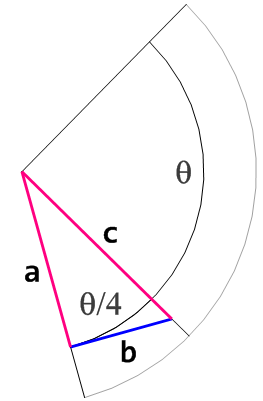GetGeomSegBulge Method
Description
Gets the bulge of a segment within the geometry in the current open Item.
The bulge factor determines the segment’s arc radius. A bulge factor of 0 defines a straight line.
The bulge factor may or may not be positive dependent on the axis of a bulge segment. The axis x, y and z component of the axis vector can be queried with the GetGeomSegAxis method.
Note: Moving a bulge segment may or may not invert the z component of the axis vector.
The bulge factor is derived from the arc radius by calculating the tangent of one-fourth of the included angle between the segment’s start and end points as shown in the figure below.
The bulge factor is tan(q/4) or b/a.

To set the bulge of a segment within the geometry in the current item, see SetGeomSegBulge
Syntax
| Visual Basic |
|---|
Public Function GetGeomSegBulge( _ ByVal nGeom As Long, _ ByVal nSeg As Long _ ) As Double |
Parameters
- nGeom
-
The index of the geometry component, starting at 0.
- nSeg
-
The index of the segment within the geometry component.
Return Type
The bulge factor is returned as a double property.
Remarks
Use GetNumGeom to get the number of geometry components in an item.Items such as blocks, groups, MultiLineStrings, and so on, can be made up of multiple geometry. Therefore the value of nGeom can be greater than 0. Items such as LineString items, polygons, symbols, and so on, are made by a single piece of geometry. Therefore the value would be 0.
Available: GEO D OD OM SISpy
Group:
Example
sis.GetGeomSegBulge(0, 0)
Evaluates the bulge of the first segment of a single piece of geometry.